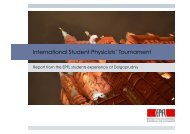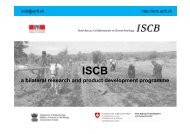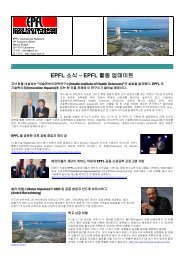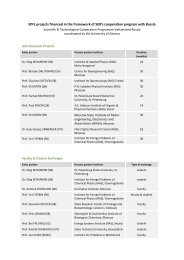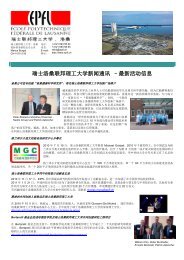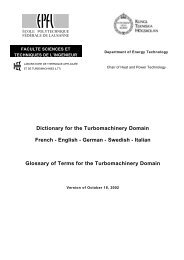Science & Technology News from Japan - International Relations
Science & Technology News from Japan - International Relations
Science & Technology News from Japan - International Relations
You also want an ePaper? Increase the reach of your titles
YUMPU automatically turns print PDFs into web optimized ePapers that Google loves.
Schweizerische Eidgenossenschaft<br />
Confédération suisse<br />
Confederazione Svizzera<br />
Confederaziun svizra<br />
First CT Scan Of Coelacanth-Fish Eggs<br />
Embassy of Switzerland in <strong>Japan</strong><br />
State Secretariat for Education and Research SER<br />
(March 20, 2009)<br />
Researchers at Tokyo Institute of <strong>Technology</strong> carried out what is believed to be the first CT<br />
scan of eggs inside a coelacanth. About 40 eggs were photographed inside each of the two<br />
coelacanths, which were captured off the coast of Tanzania, frozen and transported to Tokyo.<br />
The fishes are 170 cm long and weigh 70 kg each, while their eggs are about 7 cm in<br />
diameter. Coelacanths are thought to represent an early step in the evolution of fish to amphibians.<br />
The eggs hatch while still inside the female and the young grow to 30 cm in length before they emerge.<br />
Antibody Drug For Colorectal Cancer<br />
(March 27, 2009)<br />
Takeda Pharmaceutical Co. will market an antibody drug for colorectal cancer. Takeda currently sells only one<br />
such drug for treating prostate cancer and revenue <strong>from</strong> the cancer field accounts for only around 15% of its total<br />
sales. The company aims to broaden its lineup of cancer drugs because the market for its mainline drugs for blood<br />
pressure and other lifestyle diseases has flattened in <strong>Japan</strong>. Its patents on drugs for ulcers, blood pressure and<br />
diabetes will be expiring in the U.S. over the next few years. <strong>Japan</strong>'s Health Ministry has approved the monoclonal<br />
antibody drug, for cancers of the colon and rectum.<br />
New Antibody Drug For Ovarian Cancer In Clinical Testing<br />
(March 27, 2009)<br />
Eisai Co. will begin phase III trials in the U.S. on an antibody drug for treating ovarian cancer. The drug was developed<br />
by U.S. biopharmaceutical firm Morphotek Inc., which Eisai acquired in 2007. It is the first of the company's<br />
antibody drug candidates to make it to the third and final phase of clinical testing. The U.S. Food & Drug Administration<br />
recently approved a phase III trial in combination with standard chemotherapy drugs carboplatin and taxane<br />
to treat ovarian cancer. The antibody drug fights cancer in two ways: stimulating the immune system to attack<br />
the cancer cells and blocking a signaling pathway that promotes cell proliferation.<br />
More Efficent Cervical Cancer Vaccine<br />
(March 30, 2009)<br />
The National Institute of Infectious Diseases and other institutions have developed a next-generation vaccine<br />
against human papillomavirus (HPV). While anti-cervical cancer vaccine prevents 60% to 70% of uterine cervical<br />
cancer, the new vaccine is expected to be more effective. Of the 100 different types of HPV, 15 can cause cervical<br />
cancer. Researchers at the institute found in experiments conducted on animals that an antibody made by using a<br />
surface protein commonly found in 15 types of HPV was effective in protecting against at least eight types of HPV.<br />
Vaccines used overseas are effective against only two to four HPV types, as the vaccines are manufactured using<br />
proteins found in specific HPVs.<br />
4. Nano / Micro <strong>Technology</strong> / Material <strong>Science</strong><br />
Various Nanofiber Developments<br />
Tokyo Institute of <strong>Technology</strong> makes sheets by electro-spinning nanofibers and letting them<br />
pile up at the bottom of a container. It has also managed to grow nanofibers of zinc oxide on<br />
the surface of a sheet of carbon nanofibers. The carbon nanofibers are 100nm in diameter<br />
and the zinc oxide nanofibers are 50nm in diameter. When the surface of these zinc oxide<br />
nanofibers are coated with a photosensitive dye, the construction operates as a type of dyesensitized<br />
solar cell, generating electricity in the presence of sunlight. Kyoto University uses<br />
laser light to fabricate nanofiber structures with diameters of just tens of nanometers inside clear glass.<br />
(March 01, 2009)<br />
Nanofiber Experimental Research For New Technologies<br />
(March 08, 2009)<br />
The Nanofiber Society wants to help make sure <strong>Japan</strong> stands there at the cutting edge when the fruits of experimental<br />
research seed new nanofiber-related industries. Set up in December of last year, the society is chaired by<br />
Tokyo Institute of <strong>Technology</strong> Professor Akihiko Tanioka, whose work with organic nanofibers has taken that field<br />
to new heights. But the society is not focused entirely on organic materials and makes a point of soliciting the participation<br />
of specialists <strong>from</strong> the various branches of materials science, including inorganic materials and metals.<br />
<strong>Japan</strong> has already made a contribution to global research in this field.<br />
<strong>Science</strong> & <strong>Technology</strong> <strong>News</strong> <strong>from</strong> <strong>Japan</strong>, Template 2009 • Felix Moesner, <strong>Science</strong> & <strong>Technology</strong> Attaché Page 6 of 28










